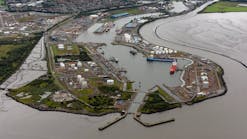I.M. Kutasov
Consultant
Los Angeles
A correlation has been developed to calculate the downhole brine density at various molal concentrations of NaCi.
The suggested equation may reduce the time and cost of laboratory density tests.
In earlier articles, we proposed an empirical equation of state (pressure-density-temperature dependence) for drilling muds and brines.1 2 I The suggested simple formula can be used to predict the density of water/oil base muds and brines at downhole conditions.
It was also shown that minimum input data are required to calculate the coefficients in this formula.
NaCI brines are widely used during drilling and workover operations to control formation pressure. To obtain the density at various molal concentrations of NaCI, the coefficients a, , and y in Equation 1 have to be solved for:
p = poeaP+(T-Ts)+y (T-Ts)2
where:
T = Temperature, F.
p = Pressure, psig
Ts = 59 F. = 15 C. (international standard temperature)
p = Fluid Density, ppg
po = Fluid density, ppg at standard conditions, p = 0 psig, T = 59 F.
a = Isothermal compressibility
and y = Constants
The density of sodium chloride solutions in the temperature and pressure ranges of 70-482 F. (21-250 C.) and 0-29,000 psig at various molal concentrations of NaCI was obtained from Reference 3.
To compare the densities of NaCI brines and water under downhole conditions we calculated for water the coefficients in Equation 1. The density-pressure-temperature data (temperature and pressure ranges of 70-464 F. and 0-29,000 psig) were taken from Reference 4.
A regression analysis computer program was used to process density-pressure-temperature data (80 points for an NaCi brine, 131 points for water) to provide the coefficients of Equation 1 (Table 1).
The accuracy of the results (R) was estimated from the sum of squared residuals and is presented in Table 1.
R = Average value of
p - p*
-------- x 100% (2)
p*
where: p* is the measured fluid density.
In Table 2, the measured and calculated densities for two sodium chloride brines are compared. The results show a good agreement between the measured and predicted densities. The relative (to water) compressibility of NaCi brines can be expressed by the Parameter B (Table 3):
B = e [(b-bw)p] (3)
where: bw = 3.2422 x 10-6 1/psig (Table 1).
The parameter At shows the temperature effect on density for sodium chloride solutions (Table 4).
At = [1 (T-Ts) +y(T-Ts)2] (4)
It is interesting to note that a 15 molal NaCI brine and water have the same compressibility. Results also show that water is more susceptible to thermal expansion than sodium chloride solutions.
REFERENCES
- Kutasov, I.M., "Empirical correlation determines downhole mud density," OGJ, Dec. 12, 1988, pp. 61-63.
- Kutasov, I.M.. "Water FV factors at higher pressures and temperatures," OGJ, Mar. 20, 1989, pp. 102-104.
- Potter, R.W. 11, and Brown, D.L., "The Volumetric Properties of Aqueous Sodium Chloride Solutions from O' to 500 C. at Pressures up to 2000 Bars Based on a Regression of Available Data in Literature," from Pleminary Tables for NaCI Solutions, Geological Survey Bulletin 1421-C, U.S. Gov't Printing Office, Washington, D.C., 1977.
- Burnham, C.W., Hollaway, J.H., and Davis, N.F., "Thermodynamic Properties of Water to 1,000 C. and 10,000 Bars," Special paper No. 132, Geological Society of America, 1969.
Copyright 1991 Oil & Gas Journal. All Rights Reserved.


